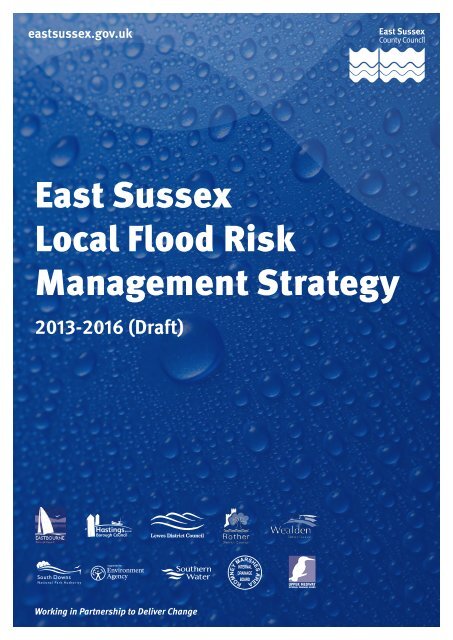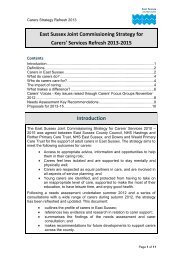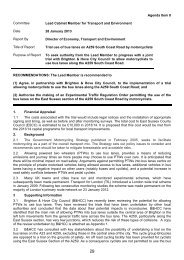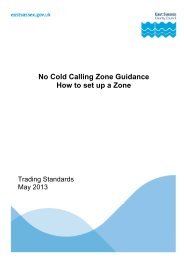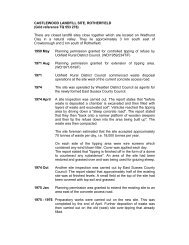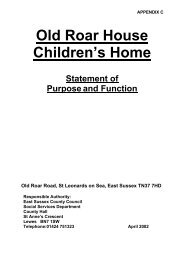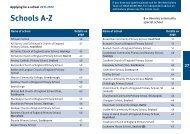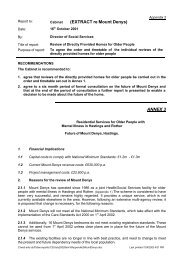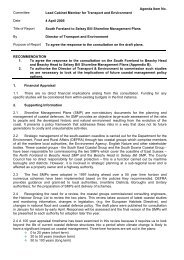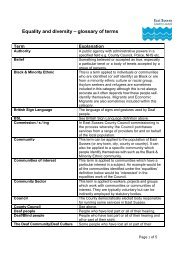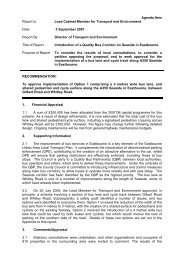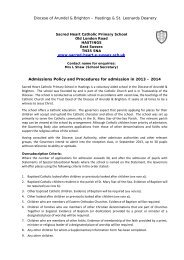Draft East Sussex Local Flood Risk Management Strategy and ...
Draft East Sussex Local Flood Risk Management Strategy and ...
Draft East Sussex Local Flood Risk Management Strategy and ...
Create successful ePaper yourself
Turn your PDF publications into a flip-book with our unique Google optimized e-Paper software.
eastsussex.gov.uk<br />
<strong>East</strong> <strong>Sussex</strong><br />
<strong>Local</strong> <strong>Flood</strong> <strong>Risk</strong><br />
<strong>Management</strong> <strong>Strategy</strong><br />
2013-2016 (<strong>Draft</strong>)<br />
INTERNAL<br />
DRAINAGE<br />
BOARD<br />
Working in Partnership to Deliver Change
Introduction<br />
1. Following widespread flooding across Engl<strong>and</strong> <strong>and</strong> Wales in 2007 the<br />
government commissioned Sir Michael Pitt to undertake an independent review to<br />
‘learn lessons’ from the floods. Pitt’s report called for fundamental changes to the<br />
way in which flooding was managed, outlining 92 recommendations, of which 21<br />
were specifically related to <strong>Local</strong> Authorities <strong>and</strong> their responsibilities.<br />
2. The report recommended that <strong>Local</strong> Authorities should play a major role<br />
in the management of local flood risk, taking the lead in tackling local flooding <strong>and</strong><br />
co-ordinating all relevant agencies. This is not surprising considering surface-water<br />
flooded two-thirds of all affected properties during 2007.<br />
3. In 2008 the Environment Agency carried out a National Assessment of<br />
<strong>Flood</strong> <strong>Risk</strong> which identified that 5.2 million – or one in six – residential <strong>and</strong><br />
commercial properties were in areas liable to flooding across Engl<strong>and</strong>. The<br />
susceptibility of properties to local flooding was again highlighted with 3.8 million,<br />
of the 5.2 million, at risk of flooding from surface-water sources.<br />
4. The <strong>Flood</strong> <strong>and</strong> Water <strong>Management</strong> Act (2010), which formed part of<br />
government’s response to the Pitt review, provides a new framework for the<br />
management of flood risk.<br />
5. The County Council, in its new role as Lead <strong>Local</strong> <strong>Flood</strong> Authority for<br />
<strong>East</strong> <strong>Sussex</strong>, now has a responsibility for flooding from local sources. That is<br />
flooding caused by:<br />
o Surface Water - <strong>Flood</strong>ing which occurs when the rate of rainfall on a surface exceeds<br />
the rate at which water can infiltrate the ground, creating runoff <strong>and</strong> pooling<br />
o Groundwater - <strong>Flood</strong>ing which occurs when water in the ground, stored in soil pore<br />
spaces or rock fractures, rises up <strong>and</strong> above the surface - <strong>and</strong><br />
o Ordinary Watercourses - <strong>Flood</strong>ing which occurs when the water flowing in a minor<br />
watercourse, such as a stream or ditch, exceeds the capacity of the channel <strong>and</strong> overtops<br />
the banks.<br />
6. This draft <strong>Strategy</strong> <strong>and</strong> its supporting technical appendices have been<br />
published for public consultation. Comments are invited on these documents<br />
during the formal consultation period between Wednesday 19 December 2012 <strong>and</strong><br />
Tuesday 12 March 2013.<br />
3
Purpose of the <strong>Strategy</strong><br />
7. Our <strong>Local</strong> <strong>Flood</strong> <strong>Risk</strong> <strong>Management</strong> <strong>Strategy</strong> has been prepared as part of<br />
the County Council’s new role as a Lead <strong>Local</strong> <strong>Flood</strong> Authority <strong>and</strong> it is consistent<br />
with the Environment Agency’s National <strong>Strategy</strong> for flooding <strong>and</strong> coastal erosion<br />
(available online at environment-agency.gov.uk/research/policy/130073.aspx). The<br />
local <strong>Strategy</strong> has been prepared in partnership with a number of key stakeholders<br />
including the ‘<strong>Risk</strong> <strong>Management</strong> Authorities’ for <strong>East</strong> <strong>Sussex</strong>.<br />
8. It is a high level, statutory document which sets out <strong>East</strong> <strong>Sussex</strong> County<br />
Council’s approach to limiting the impacts of local flooding across the county. It<br />
also promotes greater partnership working arrangements between those<br />
organisations with a responsibility for managing local flood risk <strong>and</strong> provides a<br />
strategic framework within which the ‘<strong>Risk</strong> <strong>Management</strong> Authorities’ must work.<br />
9. This is the first <strong>Local</strong> <strong>Flood</strong> <strong>Risk</strong> <strong>Management</strong> <strong>Strategy</strong> for the county. It<br />
is a ‘living document’ <strong>and</strong> will be reviewed every three years. Attached to the<br />
<strong>Strategy</strong> is the Delivery Plan outlining what activities will be progressed over the<br />
next year to address local flooding problems.<br />
The <strong>Risk</strong> <strong>Management</strong> Authorities<br />
<strong>East</strong> <strong>Sussex</strong> County Council will not be working alone - a range of other bodies<br />
known as ‘<strong>Risk</strong> <strong>Management</strong> Authorities’ also have responsibilities <strong>and</strong> duties in<br />
relation to flooding <strong>and</strong> coastal erosion.<br />
The Environment Agency is responsible for managing flooding from main<br />
rivers, the sea (including coastal erosion) <strong>and</strong> reservoirs. The Agency also<br />
maintains a strategic overview role for all forms of flooding.<br />
The County Council is the Lead <strong>Local</strong> <strong>Flood</strong> Authority for <strong>East</strong> <strong>Sussex</strong>, with a<br />
responsibility for managing flooding from local sources (surface-water,<br />
groundwater <strong>and</strong> ordinary watercourses).<br />
The County Council is also the Highway Authority for <strong>East</strong> <strong>Sussex</strong>, with a<br />
responsibility for managing flooding on the highway. The Highways Agency is<br />
not a ‘<strong>Risk</strong> <strong>Management</strong> Authority’ but is responsible for managing flooding on<br />
motorways <strong>and</strong> trunk roads.<br />
Internal Drainage Boards (IDBs) operate in some low lying areas to manage<br />
water levels <strong>and</strong> provide routine maintenance. IDBs continue to deal with<br />
flooding <strong>and</strong> drainage issues within their districts.<br />
All District <strong>and</strong> Borough Councils in <strong>East</strong> <strong>Sussex</strong> have a responsibility for<br />
coastal erosion along their shorelines.<br />
The County Council <strong>and</strong> the District <strong>and</strong> Borough Councils work collectively<br />
on Emergency Planning.<br />
Southern Water as a sewerage undertaker is responsible for managing sewer<br />
flooding across the county.<br />
A full outline of the roles <strong>and</strong> responsibilities of the <strong>Risk</strong> <strong>Management</strong> Authorities<br />
in <strong>East</strong> <strong>Sussex</strong> can be found in Section 4 of the <strong>Local</strong> <strong>Flood</strong> <strong>Risk</strong> <strong>Management</strong><br />
<strong>Strategy</strong> Technical Appendices.<br />
4
Issues <strong>and</strong> Objectives<br />
10. It is not possible to prevent all flooding but <strong>East</strong> <strong>Sussex</strong> County Council<br />
will work, with its partners, to manage <strong>and</strong> limit the impacts of local flooding on<br />
communities across the county.<br />
11. <strong>Flood</strong>ing from local sources cannot be tackled in isolation as multiple<br />
sources often combine to produce a flood event. Over time we will work to provide<br />
a co-ordinated strategy for flooding from all sources including coastal erosion. This<br />
vision is reflected within the <strong>Strategy</strong>’s guiding principle <strong>and</strong> objectives.<br />
12. <strong>Flood</strong>ing is a natural process which shapes our environment, but it can<br />
also pose a threat to the safety <strong>and</strong> wellbeing of communities.<br />
13. The impacts of flooding include:<br />
o Damage to residential <strong>and</strong> commercial property, key services <strong>and</strong><br />
infrastructure such as roads <strong>and</strong> hospitals, as well as<br />
o Damage to agricultural l<strong>and</strong> <strong>and</strong> crops.<br />
o Increases in the cost of, or an inability to gain access to, flood insurance;<br />
o Health related impacts (both physical <strong>and</strong> psychological); <strong>and</strong><br />
o Environmental impacts such as the pollution of watercourses harming<br />
wildlife <strong>and</strong> habitats.<br />
14. <strong>Flood</strong>ing can also be beneficial. With careful management storing water<br />
in selected ‘low’ risk areas can provide flood protection, whilst also allowing habitat<br />
creation <strong>and</strong> providing amenity value. For an outline of the added benefits that can<br />
be achieved through flood protection, along with details of key projects taking place<br />
across the county, please refer to Section 3 of the <strong>Local</strong> <strong>Flood</strong> <strong>Risk</strong> <strong>Management</strong><br />
<strong>Strategy</strong> Technical Appendices.<br />
15. Evidence suggests that damage caused by flooding is likely to increase<br />
unless it is managed effectively.<br />
16. Future pressures which will impact on effective flood risk management<br />
include:<br />
o Climate Change leading to more intense periods of rainfall, thus increasing<br />
the frequency of large-scale flooding <strong>and</strong> the chances of flooding occurring<br />
where it has not been observed before;<br />
o Sea-level rise affecting drainage <strong>and</strong> groundwater levels in coastal areas;<br />
o Heightened river levels preventing surface-water from draining from<br />
riverside towns <strong>and</strong> development;<br />
o Population increase <strong>and</strong> changes in its structure (such as an ageing<br />
population) will raise the dem<strong>and</strong> for development <strong>and</strong> key services;<br />
o Growth pressures seeing new development in areas at risk of flooding or<br />
creating risk elsewhere; <strong>and</strong><br />
o Deterioration of structures or features that currently protect us from flooding<br />
<strong>and</strong> thus require maintenance or replacement.<br />
5
17. Taking into account these issues, the guiding principle of the <strong>East</strong><br />
<strong>Sussex</strong> <strong>Local</strong> <strong>Flood</strong> <strong>Risk</strong> <strong>Management</strong> <strong>Strategy</strong> is:<br />
To provide local leadership <strong>and</strong> work in partnership with public bodies,<br />
businesses, community groups, voluntary sector organisations <strong>and</strong> local<br />
people to manage the risk <strong>and</strong> associated social, economic <strong>and</strong><br />
environmental impacts of flooding <strong>and</strong> coastal erosion across <strong>East</strong> <strong>Sussex</strong>.<br />
18. This <strong>Strategy</strong> will work towards achieving the following objectives:<br />
i. Establish <strong>and</strong> maintain effective partnerships with key organisations <strong>and</strong><br />
local communities in order to develop collective knowledge, share best practice<br />
<strong>and</strong> secure funding for local flood risk management measures.<br />
ii. Improve the evidence base <strong>and</strong> underst<strong>and</strong>ing of local flood risk to ensure<br />
that limited resources are targeted in the areas of highest risk <strong>and</strong> vulnerability.<br />
iii. Empower local communities <strong>and</strong> l<strong>and</strong> owners to take action in order to be<br />
prepared for <strong>and</strong> limit the impacts of flooding.<br />
iv. Avoid increasing flood <strong>and</strong> coastal erosion risk by encouraging best practice<br />
for the maintenance of assets <strong>and</strong> preventing inappropriate development.<br />
v. Work in partnership to deliver cost-effective flood <strong>and</strong> coastal erosion risk<br />
management measures which take a catchment wide approach <strong>and</strong> contribute<br />
to wider social, economic <strong>and</strong> environmental outcomes.<br />
19. This <strong>Strategy</strong> has drawn on, <strong>and</strong> is complementary to, the following key<br />
policies of the County Council:<br />
o The <strong>East</strong> <strong>Sussex</strong> Strategic Partnership’s ‘Pride of Place’ Sustainability<br />
<strong>Strategy</strong> (2008 – 2026);<br />
o <strong>East</strong> <strong>Sussex</strong> County Council’s Climate Change <strong>Strategy</strong> <strong>and</strong><br />
o <strong>East</strong> <strong>Sussex</strong> County Council’s Environment <strong>Strategy</strong>.<br />
20. For more details of the key policies <strong>and</strong> legislation that have driven this<br />
<strong>Strategy</strong>, please refer to Section 2 of the <strong>Local</strong> <strong>Flood</strong> <strong>Risk</strong> <strong>Management</strong> <strong>Strategy</strong><br />
Technical Appendices.<br />
6
The <strong>Strategy</strong> Area<br />
21. This <strong>Strategy</strong> covers the County of <strong>East</strong> <strong>Sussex</strong>, an area of 1,725 km 2<br />
(660 square miles) <strong>and</strong> includes the Districts of Lewes, Rother <strong>and</strong> Wealden <strong>and</strong><br />
Boroughs of <strong>East</strong>bourne <strong>and</strong> Hastings.<br />
22. In March 2011 the population of the county stood at 526, 700, with 75%<br />
of people living in urban areas along the coastal strip as highlighted by the map<br />
above.<br />
23. <strong>East</strong> <strong>Sussex</strong> is widely recognised for its high quality l<strong>and</strong>scape. The High<br />
Weald Area of Outst<strong>and</strong>ing Natural Beauty, the South Downs National Park <strong>and</strong><br />
the Heritage Coastline which includes the Seven Sisters all fall within <strong>East</strong> <strong>Sussex</strong>.<br />
The County also possesses a wide range of protected environmental <strong>and</strong> heritage<br />
sites of international, national <strong>and</strong> local importance. A detailed overview of the<br />
physical, social <strong>and</strong> economic characteristics of <strong>East</strong> <strong>Sussex</strong> can be found in<br />
Section 1 of the <strong>Local</strong> <strong>Flood</strong> <strong>Risk</strong> <strong>Management</strong> <strong>Strategy</strong> Technical Appendices.<br />
24. Recognising that the movement of water through the l<strong>and</strong>scape is not<br />
limited by administrative boundaries, the County Council will look beyond its<br />
borders <strong>and</strong> work (with key partners) across river catchments <strong>and</strong> along the coast<br />
to address flooding problems.<br />
7
The Focus<br />
25. Using information available to the County Council local flood risk has<br />
been assessed across <strong>East</strong> <strong>Sussex</strong>. A number of local flooding hotspots (14 in<br />
total) have been identified, as highlighted on the map below. These hotspots will<br />
help us to target our resources to where they are needed the most. Our priorities<br />
will be determined by a number of factors including levels of deprivation,<br />
vulnerability <strong>and</strong> locations where the greatest numbers of people, businesses <strong>and</strong><br />
assets are affected.<br />
<strong>Local</strong>ised flooding hotspots across <strong>East</strong> <strong>Sussex</strong><br />
26. A technical note outlining how risk has been assessed for the purpose of<br />
this <strong>Strategy</strong> can be found in Section 5 of the <strong>Local</strong> <strong>Flood</strong> <strong>Risk</strong> <strong>Management</strong><br />
<strong>Strategy</strong> Technical Appendices.<br />
8
What is <strong>Flood</strong> <strong>Risk</strong><br />
<strong>Flood</strong>ing is a hazard as it has the potential to cause harm to human health <strong>and</strong> life,<br />
<strong>and</strong> effect the natural <strong>and</strong> built environment.<br />
The term ‘risk’ acknowledges the actual harm caused <strong>and</strong> is different to a hazard.<br />
<strong>Flood</strong> <strong>Risk</strong> is a combination of the probability or likelihood of a flood event<br />
occurring <strong>and</strong> the severity of its impacts:<br />
RISK = LIKELIHOOD x SEVERITY<br />
<strong>Flood</strong>ing is only a risk when there is a means of connecting the flood source, by<br />
means of a pathway or route for the flood waters, with people, property or<br />
agricultural l<strong>and</strong> (the receptor).<br />
SOURCE<br />
PATHWAY<br />
RECEPTOR<br />
e.g. river, sea,<br />
minor watercourse<br />
e.g. breached defence,<br />
floodplain<br />
e.g. people, properties,<br />
agricultural l<strong>and</strong><br />
<strong>Risk</strong> captures the severity of, or related consequences produced by, a flood event.<br />
Impacts can be social, economic <strong>and</strong> environmental, such as the number of<br />
properties flooded <strong>and</strong> the level of associated economic damages. The<br />
consequences of a flood depend on the level of exposure <strong>and</strong> the vulnerability of<br />
those affected. For example, an ambulance station required to be operational<br />
during a flood event or basement flats would be more vulnerable to (equivalent)<br />
flooding than buildings used for agriculture <strong>and</strong> forestry.<br />
The <strong>Local</strong> <strong>Flood</strong> <strong>Risk</strong> <strong>Management</strong> <strong>Strategy</strong><br />
27. The County Council will go beyond its statutory duties as a Lead <strong>Local</strong><br />
<strong>Flood</strong> Authority to help deliver the recommendations <strong>and</strong> vision of the Pitt Review.<br />
28. Working with the other ‘<strong>Risk</strong> <strong>Management</strong> Authorities’ <strong>and</strong> key<br />
stakeholders the County Council will aim to deliver a co-ordinated <strong>and</strong> effective<br />
approach to flood risk management, avoiding inefficiencies <strong>and</strong> duplication of<br />
effort.<br />
29. <strong>Flood</strong>ing across the County originates from a number of different sources<br />
(local, river, coastal) <strong>and</strong> often these combine heightening the risk to communities.<br />
The long-term aim of this <strong>Strategy</strong> is to integrate flood risk management.<br />
Challenges Ahead<br />
30. The guiding principle <strong>and</strong> objectives frame this <strong>Local</strong> <strong>Flood</strong> <strong>Risk</strong><br />
<strong>Management</strong> <strong>Strategy</strong> <strong>and</strong> set out what we want to achieve in the long-term.<br />
However, there are still a number of key challenges that the County Council faces<br />
in its new role as a Lead <strong>Local</strong> <strong>Flood</strong> Authority which it will need to overcome:<br />
o The responsibility for local flooding is a new role entirely <strong>and</strong> has not been<br />
transferred from another organisation;<br />
9
o The County Council must develop its in-house skills <strong>and</strong> capacity to deliver<br />
this new role effectively;<br />
o There is a lack of evidence <strong>and</strong> data to support decisions due to under<br />
investment into research <strong>and</strong> investigation on local flooding in the past;<br />
o The <strong>Flood</strong> <strong>and</strong> Water <strong>Management</strong> Act (2010) has not simplified the<br />
framework for authorities involved in local flood risk management;<br />
o The local flood risk management role of District <strong>and</strong> Borough Councils is<br />
not defined in the Act;<br />
o There is limited funding to deliver works on the ground to address local<br />
flooding issues so actions must be prioritised; <strong>and</strong><br />
o There are a number of plans which address flooding from different sources,<br />
such as Catchment <strong>Flood</strong> <strong>Management</strong> Plans <strong>and</strong> Shoreline <strong>Management</strong><br />
Plans. We need to develop new ways of working to overcome the artificial<br />
barriers to partnership working these can create.<br />
31. Action Points set out below demonstrate how we will begin to tackle these<br />
challenges <strong>and</strong> manage local flood risk across <strong>East</strong> <strong>Sussex</strong>.<br />
Partnerships<br />
32. The <strong>Flood</strong> <strong>and</strong> Water <strong>Management</strong> Act was intended to streamline flood<br />
risk responsibilities but these still remain divided between a number of authorities<br />
<strong>and</strong> are not clearly defined in all cases. Partnership working is therefore essential<br />
to the delivery of effective flood risk management.<br />
33. By working together, we can avoid duplication of effort, maximise<br />
available resources <strong>and</strong> funding opportunities <strong>and</strong> share best practice, skills <strong>and</strong><br />
expertise.<br />
Action Points<br />
The active involvement of all <strong>Risk</strong> <strong>Management</strong> Authorities is crucial to this<br />
<strong>Strategy</strong>’s success so the County Council will continue to maintain key<br />
partnerships within the county <strong>and</strong> across the South <strong>East</strong>.<br />
The County Council will seek to widen its partnership arrangements to work<br />
with other organisations <strong>and</strong> stakeholders; such as local flood groups, town<br />
<strong>and</strong> parish councils, utility companies as well as property owners.<br />
The County Council will also continue to lobby the Department for<br />
Environment, Food <strong>and</strong> Rural Affairs (Defra) to clarify the role of District <strong>and</strong><br />
Borough Councils in relation to local flood risk management.<br />
10
Key Partnerships<br />
South <strong>East</strong> Seven – a partnership of seven upper tier local authorities (county<br />
<strong>and</strong> unitary councils) in the South <strong>East</strong> that are committed to working together on<br />
a set of key work areas, including flood risk management. The members of the<br />
partnership are:<br />
o<br />
o<br />
o<br />
o<br />
o<br />
o<br />
o<br />
<strong>East</strong> <strong>Sussex</strong> County Council;<br />
West <strong>Sussex</strong> County Council;<br />
Surrey County Council;<br />
Hampshire County Council;<br />
Kent County Council;<br />
Medway Council <strong>and</strong><br />
Brighton <strong>and</strong> Hove City Council.<br />
The group share expertise <strong>and</strong> work to deliver shared services.<br />
The <strong>East</strong> <strong>Sussex</strong> <strong>Flood</strong> Partnership – a partnership of the <strong>Risk</strong> <strong>Management</strong><br />
Authorities in <strong>East</strong> <strong>Sussex</strong> (including the South Downs National Park Authority)<br />
which meets on a quarterly basis to provide a strategic overview of flood risk<br />
management work within the county.<br />
Lewes IUDS – emerged from the Lewes (town) Integrated Urban Drainage Study<br />
pilot in 2008. This partnership led by Lewes District Council seeks to address<br />
longst<strong>and</strong>ing drainage issues affecting the town <strong>and</strong> raise community awareness<br />
of local flooding.<br />
Improving the Evidence Base for <strong>Local</strong> <strong>Flood</strong> <strong>Risk</strong> <strong>Management</strong><br />
34. The County Council will continue to build a clear <strong>and</strong> robust evidence<br />
base to support this <strong>Strategy</strong> <strong>and</strong> its new role. Without the regular review <strong>and</strong><br />
updating of flood risk information our underst<strong>and</strong>ing of local problems will remain<br />
incomplete. This could result in delaying or preventing actions on the ground to<br />
address local flooding issues.<br />
35. A number of focused studies on local flooding, its mechanisms <strong>and</strong><br />
consequences have already been undertaken across the County. These have<br />
taken place in:<br />
o <strong>East</strong>bourne <strong>and</strong> South Wealden;<br />
o Hastings; <strong>and</strong>,<br />
o Lewes.<br />
36. A more robust evidence base will assist the County Council, <strong>and</strong> its<br />
partners, in displaying the costs <strong>and</strong> benefits of local flooding schemes; helping us<br />
to secure funds both centrally <strong>and</strong> locally. Quick-wins <strong>and</strong> the need for funding will<br />
be easier to display. Further details of the mechanisms through which funding is<br />
secured can be found in Section 7 of the <strong>Local</strong> <strong>Flood</strong> <strong>Risk</strong> <strong>Management</strong> <strong>Strategy</strong><br />
Technical Appendices.<br />
11
Action Points<br />
Given sufficient funding, the <strong>Risk</strong> <strong>Management</strong> Authorities will continue to<br />
undertake local studies <strong>and</strong> assessments. Knowledge gained can be fed<br />
back into this <strong>Strategy</strong>, helping us to establish more locally relevant <strong>and</strong><br />
realistic options to address flooding issues.<br />
Information gathering will be aided by the County Council’s new flood<br />
investigation role. More details of this role can be found in Section 4 of the<br />
<strong>Local</strong> <strong>Flood</strong> <strong>Risk</strong> <strong>Management</strong> <strong>Strategy</strong> Technical Appendices.<br />
Further sharing of knowledge, data <strong>and</strong> best practice will be encouraged<br />
between the <strong>Risk</strong> <strong>Management</strong> Authorities by formalising data sharing<br />
arrangements. This will be achieved with the support of the Environment<br />
Agency, Defra <strong>and</strong> the <strong>Local</strong> Government Association.<br />
The County Council <strong>and</strong> the other <strong>Risk</strong> <strong>Management</strong> Authorities for <strong>East</strong><br />
<strong>Sussex</strong> will continue to pursue opportunities to participate in pilot projects<br />
<strong>and</strong> initiatives, where necessary <strong>and</strong> appropriate. This will help build our<br />
internal knowledge <strong>and</strong> capacity as well as advance underst<strong>and</strong>ing within<br />
the flooding <strong>and</strong> water sector as a whole. Past examples include:<br />
- The Lewes Integrated Urban Drainage Study Pilot 2008, <strong>and</strong><br />
- The <strong>East</strong> <strong>Sussex</strong> County Council Strategic Investment Plan Pilot<br />
2011 - 2012.<br />
Prioritising Actions to Address <strong>Local</strong> <strong>Flood</strong>ing<br />
37. Key to our <strong>Strategy</strong>’s approach to tackling local flooding, taking into<br />
account the uncertainties surrounding this new role, is proportionality.<br />
38. It is not technically, economically or environmentally possible to remove<br />
all flood risk. The County Council <strong>and</strong> its partners must invest limited resources to<br />
their best effect, in other words gaining the maximum benefit for every pound<br />
spent. The 14 local flooding hotspots identified as part of our assessment will act<br />
as a focus for our efforts <strong>and</strong> we will need to conduct further work to determine<br />
feasible options for reducing risk at these locations.<br />
39. However, by focussing on these hotspots alone we will ignore the risk<br />
faced by the county’s rural communities. It will be necessary for rural flood risk to<br />
be treated in the same proportionate approach. Issues will be identified through the<br />
County Council’s new flood investigatory role <strong>and</strong> ordinary watercourse consenting<br />
<strong>and</strong> enforcement responsibilities. The other <strong>Risk</strong> <strong>Management</strong> Authorities, local<br />
flood groups or parish councils should also bring flooding <strong>and</strong> maintenance issues<br />
to the attention of the Lead <strong>Local</strong> <strong>Flood</strong> Authority.<br />
Action Point<br />
Resources to address flooding issues will be allocated in a proportionate<br />
manner, focusing on areas where the greatest social, economic <strong>and</strong><br />
environmental benefits can be delivered.<br />
Communications<br />
40. Effective communication is key to ensuring that:<br />
o Those liable to flooding are aware of the risk they face <strong>and</strong> can take<br />
appropriate action to minimise it; <strong>and</strong><br />
12
o Those who may worsen flooding problems are aware of their<br />
responsibilities <strong>and</strong> the effects that their actions, or lack of action, may<br />
have.<br />
41. Raising community awareness is a key priority for this <strong>Strategy</strong>. <strong>Flood</strong><br />
risk can not be removed entirely but we can work to help prepare individuals <strong>and</strong><br />
communities by providing the right information to those who need it.<br />
42. Organisations such as the National <strong>Flood</strong> Forum, the Association of<br />
Drainage Authorities, the Environment Agency, Southern Water <strong>and</strong> the <strong>Sussex</strong><br />
Resilience Forum (the Emergency Planning Authorities of <strong>East</strong> <strong>and</strong> West <strong>Sussex</strong>)<br />
all have a role in informing communities of the risks they face <strong>and</strong> what should be<br />
done to minimise it.<br />
Action Point<br />
o The County Council <strong>and</strong> its partners will undertake focussed awareness<br />
raising programmes highlighting the actions communities can take to<br />
minimise the impacts of flooding.<br />
Maintenance <strong>and</strong> Drainage Issues<br />
43. Sir Michael Pitt’s Report identified that a lack of maintenance of existing<br />
flood risk management assets (such as ditches, highway drainage, watercourses<br />
<strong>and</strong> other drainage features) was a key contributory factor to the 2007 summer<br />
floods.<br />
44. Without regular maintenance the designed level of protection provided by<br />
such assets will continue to diminish over time. The impacts of climate change are<br />
expected to raise the probability of flooding <strong>and</strong> erosion <strong>and</strong> will require the<br />
enhancement of assets. Assets will also reach the end of their design life <strong>and</strong><br />
require replacement, refurbishment or further maintenance which will increase the<br />
overall costs of flood protection. This is further complicated, as the Lead <strong>Local</strong><br />
<strong>Flood</strong> Authority cannot insist on the maintenance of assets not in its control.<br />
Action Points<br />
<strong>East</strong> <strong>Sussex</strong> County Council (as a Lead <strong>Local</strong> <strong>Flood</strong> Authority <strong>and</strong> Highway<br />
Authority) along with its other <strong>Risk</strong> <strong>Management</strong> Authority partners will work to:<br />
o Raise awareness of asset ownership <strong>and</strong> the importance of regular<br />
maintenance;<br />
o Raise awareness of the responsibilities of riparian ownership i.e. those who<br />
have a watercourse running through or adjacent to their l<strong>and</strong>;<br />
o Produce an Asset Register of key structures or features for local flooding<br />
<strong>and</strong> make this publicly available;<br />
o Seek to identify the responsibility for ‘orphan’ or unclaimed assets, so that<br />
they do not remain unmaintained; <strong>and</strong> will<br />
o Where necessary, use powers under the L<strong>and</strong> Drainage Act (1991) to<br />
ensure that l<strong>and</strong> owners maintain their watercourses.<br />
13
The facts about Riparian Ownership<br />
Does a watercourse flow within, or next to your l<strong>and</strong> or property<br />
If YES, then read ‘Living on the Edge’, guidance from the Environment<br />
Agency which sets out the responsibilities of riparian owners. This is available<br />
online at environment-agency.gov.uk/home<strong>and</strong>leisure/floods/31626.aspx.<br />
Planning<br />
45. Integrating local flood risk management <strong>and</strong> the planning system is a key<br />
priority. This <strong>Strategy</strong> looks toward limiting the risk to, or caused by, new<br />
development. <strong>Flood</strong>ing issues should be considered at the very earliest stages of<br />
site identification <strong>and</strong> design.<br />
46. The National Planning Policy Framework requires local planning<br />
authorities (including the South Downs National Park Authority) to consider all flood<br />
risk when drafting development plans <strong>and</strong> in making decisions on development<br />
proposals.<br />
47. Our assessment of local flood risk (which will be regularly reviewed) will<br />
assist in refining the Strategic <strong>Flood</strong> <strong>Risk</strong> Assessments which inform the<br />
development strategies of the local planning authorities within <strong>East</strong> <strong>Sussex</strong> i.e.<br />
District <strong>and</strong> Borough Councils <strong>and</strong> the South Downs National Park Authority.<br />
48. Once government commences Schedule 3 <strong>and</strong> related sections of the<br />
<strong>Flood</strong> <strong>and</strong> Water <strong>Management</strong> Act, the County Council will become a Sustainable<br />
Drainage Approving Body, or SAB. All development over certain thresholds will<br />
need to secure drainage approval before construction begins. This gives the<br />
County Council the opportunity to ensure that new drainage proposals do not<br />
contribute to the overloading of the drainage network causing flooding. It also<br />
provides opportunities to deliver improvements to water quality, wildlife, habitats<br />
<strong>and</strong> local amenity.<br />
Action Points<br />
The County Council will:<br />
o Produce county-wide Sustainable Drainage guidance to assist developers<br />
<strong>and</strong> planners;<br />
o Contribute to regional guidance on the use of sustainable drainage in the<br />
master planning of larger sites <strong>and</strong> how environmental, amenity <strong>and</strong><br />
flooding solutions can be integrated; <strong>and</strong><br />
o Work with the local planning authorities in <strong>East</strong> <strong>Sussex</strong> to ensure that the<br />
planning <strong>and</strong> drainage approval processes work together effectively.<br />
Funding<br />
49. The funding available to <strong>East</strong> <strong>Sussex</strong> County Council for its new role as a<br />
Lead <strong>Local</strong> <strong>Flood</strong> Authority <strong>and</strong> for delivering local flood risk schemes is limited<br />
<strong>and</strong> the government’s priority on reducing the national debt will continue to place a<br />
downward pressure on budgets.<br />
50. However, the government’s new partnership funding approach<br />
encourages communities <strong>and</strong> stakeholders to take more responsibility for the flood<br />
14
isk they face <strong>and</strong> aims to increase overall investment beyond that which can be<br />
provided centrally.<br />
51. The County Council has successfully secured funding for a number of<br />
local flooding projects via partnership contributions <strong>and</strong> from local levy raised<br />
through the Southern Regional <strong>Flood</strong> <strong>and</strong> Coastal Committee. Such projects will<br />
help to lower the risk to householders <strong>and</strong> businesses <strong>and</strong> help to deliver change<br />
for communities on the ground. Further details of schemes being progressed are<br />
included within the <strong>Strategy</strong>’s Delivery Plan.<br />
Action Points<br />
The County Council will:<br />
Seek new <strong>and</strong> alternative sources of funding to ‘top-up’ funds so more local<br />
flooding schemes can progress;<br />
Pool resources with local <strong>and</strong> regional partners where necessary <strong>and</strong><br />
appropriate; <strong>and</strong><br />
With the help of the other <strong>Risk</strong> <strong>Management</strong> Authorities, identify <strong>and</strong> submit<br />
new projects for funding approval.<br />
52. For more details of the funding process, refer to Section 7 of the <strong>Local</strong><br />
<strong>Flood</strong> <strong>Risk</strong> <strong>Management</strong> <strong>Strategy</strong> Technical Appendices.<br />
What is being done where I live<br />
To easily identify flooding schemes being undertaken in your area visit<br />
environment-agency.gov.uk/home<strong>and</strong>leisure/131801 <strong>and</strong> utilise the postcode<br />
search function.<br />
The map shows flooding <strong>and</strong> coastal erosion schemes that have received<br />
funding this financial year <strong>and</strong> which may receive government funding in the<br />
next.<br />
Next Steps<br />
53. The <strong>East</strong> <strong>Sussex</strong> <strong>Local</strong> <strong>Flood</strong> <strong>Risk</strong> <strong>Management</strong> <strong>Strategy</strong> sets out how<br />
the County Council, in partnership with the other <strong>Risk</strong> <strong>Management</strong> Authorities <strong>and</strong><br />
key stakeholders, will manage local flooding issues across <strong>East</strong> <strong>Sussex</strong> over the<br />
next three years.<br />
54. This <strong>Strategy</strong> represents the first step towards a co-ordinated strategy for<br />
flood risk from all sources, but from the outset dem<strong>and</strong>s effective <strong>and</strong> meaningful<br />
working arrangements between the <strong>Risk</strong> <strong>Management</strong> Authorities if it is to be<br />
successful.<br />
55. The key focus for the first three years is building in-house capacity, as<br />
well as a robust evidence base to support effective decision making through the<br />
undertaking of local studies <strong>and</strong> assessments. A number of schemes to address<br />
local flooding problems on the ground will also be developed <strong>and</strong> delivered.<br />
15
Delivery Plan<br />
56. The following table sets out the actions that will be progressed over the<br />
coming year by the <strong>Risk</strong> <strong>Management</strong> Authorities in <strong>East</strong> <strong>Sussex</strong> <strong>and</strong> other key<br />
partners. These actions will help work towards achieving the <strong>Local</strong> <strong>Flood</strong> <strong>Risk</strong><br />
<strong>Management</strong> <strong>Strategy</strong>’s objectives.<br />
57. The managing <strong>and</strong> supporting partners who will deliver each action are<br />
detailed as well as the timescales over which the actions will be achieved.<br />
58. The Delivery Plan will be reviewed on an annual basis.<br />
16
Objective<br />
Establish <strong>and</strong> maintain<br />
effective partnerships with<br />
key organisations <strong>and</strong> local<br />
communities in order to<br />
develop collective<br />
knowledge, share best<br />
practice <strong>and</strong> secure<br />
funding for local flood risk<br />
management measures<br />
Actions<br />
1) Ensure continued engagement <strong>and</strong> progress reporting with<br />
key partners on flood <strong>and</strong> coastal erosion risk management<br />
issues through the <strong>East</strong> <strong>Sussex</strong> <strong>Flood</strong> Partnership<br />
2) Periodically review partner roles, responsibilities <strong>and</strong><br />
statutory duties<br />
Develop <strong>and</strong> agree a protocol between <strong>Flood</strong> <strong>Risk</strong><br />
<strong>Management</strong>, the Highway Authority, Emergency Planning,<br />
Planning Development Control <strong>and</strong> Transport Development<br />
Control to ensure that roles <strong>and</strong> responsibilities are defined <strong>and</strong><br />
that flood risk management is an integral part of the delivery of<br />
services<br />
Establish procedural arrangements for approving sustainable<br />
drainage applications between ESCC <strong>and</strong> <strong>Local</strong> Planning<br />
Authorities<br />
Regional liaison on flood risk matters with southern Lead <strong>Local</strong><br />
<strong>Flood</strong> Authorities through the South <strong>East</strong> Seven<br />
Regional Liaison through the Southern Regional <strong>Flood</strong> <strong>and</strong><br />
Coastal Committee<br />
Exp<strong>and</strong> the scope of the Lewes Integrated Urban Drainage<br />
Study Partnership to include the entirety of Lewes District <strong>and</strong><br />
formalise partnership arrangements<br />
Continued engagement with the Development Control Forum<br />
<strong>and</strong> Drainage Working Group on the integration of sustainable<br />
drainage systems, drainage matters <strong>and</strong> the planning system<br />
Assess the potential for securing Resilience Partnership<br />
funding for local flooding hotspots <strong>and</strong> develop an approach for<br />
providing support to those at risk of flooding in rural areas<br />
Delivery<br />
Partner(s)<br />
ESCC<br />
Supporting<br />
Partner(s)<br />
All RMAs<br />
SDNPA<br />
Time frame<br />
1) Ongoing<br />
2) On review of<br />
the <strong>Strategy</strong><br />
ESCC / 2013 - 14<br />
ESCC<br />
WSCC<br />
EA<br />
EBC, HBC,<br />
LDC, RDC,<br />
WDC, SDNPA<br />
ESCC,KCC,<br />
HCC, B&HCC,<br />
SCC, MC<br />
All relevant<br />
LLFAs<br />
including ESCC<br />
In time for<br />
commencement<br />
Three - Six<br />
monthly meetings<br />
Ongoing<br />
quarterly<br />
meetings<br />
LDC ESCC, EA, SW Spring 2013<br />
ESCC<br />
EBC, HBC,<br />
LDC, RDC,<br />
WDC<br />
All RMAs<br />
SDNPA<br />
ESCC<br />
EA<br />
RFCC<br />
Ongoing<br />
Ongoing<br />
engagement in<br />
the Medium Term<br />
Plan process<br />
17
Objective<br />
Actions<br />
Delivery<br />
Partner(s)<br />
Supporting<br />
Partner(s)<br />
Time frame<br />
Clarify an approach for identifying surface-water drainage<br />
improvements which additionally contribute to sewer flooding<br />
solutions<br />
ESCC,<br />
SW<br />
EA,<br />
EBC,HBC,<br />
LDC,<br />
RDC,WDC<br />
2013<br />
Improve the evidence base<br />
<strong>and</strong> underst<strong>and</strong>ing of local<br />
flood risk to ensure that<br />
limited resources are<br />
targeted in the areas of<br />
highest risk <strong>and</strong><br />
vulnerability<br />
Work with communities, l<strong>and</strong> owners <strong>and</strong> managers to develop<br />
a sustainable approach to managing water levels <strong>and</strong><br />
maintaining assets in low lying areas <strong>and</strong> the wider catchment<br />
Review the <strong>East</strong> <strong>Sussex</strong> Preliminary <strong>Flood</strong> <strong>Risk</strong> Assessment<br />
Continue to develop LLFA resources <strong>and</strong> capacity to fulfil<br />
statutory requirements<br />
Develop a comprehensive flood investigation procedure, so<br />
that flood events are investigated where it is deemed<br />
necessary <strong>and</strong> appropriate<br />
Commence <strong>East</strong>bourne Town Centre Surface Water<br />
Assessment<br />
EA<br />
NE<br />
ESCC<br />
ESCC,<br />
Defra, EA,<br />
LGA<br />
ESCC<br />
ESCC<br />
EBC,HBC,<br />
LDC,<br />
RDC,WDC,<br />
SDNPA<br />
Community <strong>and</strong><br />
l<strong>and</strong> owner<br />
groups<br />
All RMAs<br />
SDNPA<br />
All RMAs<br />
SDNPA<br />
All RMAs<br />
SDNPA<br />
2014<br />
June 2017<br />
Ongoing<br />
2013<br />
ESCC EBC, SW, EA 2012 - 13<br />
Commence Uckfield Town Centre, Surface Water Assessment ESCC WDC, SW,EA 2012 – 13<br />
Develop <strong>and</strong> maintain a consistent approach to recording <strong>and</strong><br />
designating flood assets, including information regarding their<br />
significance to flood <strong>and</strong> coastal erosion risk management,<br />
their condition <strong>and</strong> ownership<br />
ESCC<br />
EA<br />
All RMAs<br />
2013<br />
18
Objective<br />
Actions<br />
Delivery<br />
Partner(s)<br />
Supporting<br />
Partner(s)<br />
Time frame<br />
Develop <strong>and</strong> maintain a consistent approach:<br />
1) for sharing data;<br />
2) for capturing flood incident data <strong>and</strong><br />
3) to ensure format compatibility in relation to the recording of<br />
flood assets <strong>and</strong> consents<br />
1) ESCC<br />
2) ESCC<br />
3) EA<br />
All RMAs<br />
SDNPA<br />
1) 2013<br />
2) 2014<br />
3) 2013<br />
Develop a targeted communications strategy to improve<br />
awareness <strong>and</strong> underst<strong>and</strong>ing of local flood risk, related<br />
responsibilities <strong>and</strong> to catalyse action<br />
ESCC<br />
All RMAs<br />
SDNPA<br />
<strong>Local</strong> <strong>Flood</strong><br />
<strong>and</strong> Community<br />
Groups<br />
2013 - 14<br />
Empower local<br />
communities <strong>and</strong> l<strong>and</strong><br />
owners to take action in<br />
order to be prepared for<br />
<strong>and</strong> limit the impacts of<br />
flooding<br />
Avoid increasing flood <strong>and</strong><br />
coastal erosion risk by<br />
encouraging best practice<br />
for the maintenance of<br />
assets <strong>and</strong> preventing<br />
inappropriate development<br />
Promote transparency <strong>and</strong> public accountability of <strong>Risk</strong><br />
<strong>Management</strong> Authority activities through ESCC’s Scrutiny<br />
Committee process <strong>and</strong> develop indicators to assess progress<br />
Community groups to identify local flood risk issues <strong>and</strong> to<br />
progress potential flood risk solutions<br />
Work with community groups to promote <strong>and</strong> support the<br />
establishment of local flood groups <strong>and</strong> emergency plans<br />
where necessary <strong>and</strong> appropriate<br />
Develop guidance <strong>and</strong> procedures which help to achieve<br />
sustainable outcomes:<br />
1) Updated guidance for the scoping of consent <strong>and</strong><br />
sustainable drainage applications in relation to Water<br />
Framework Directive Assessment<br />
2) Produce regional sustainable drainage <strong>and</strong> master planning<br />
guidance for developers<br />
3) Produce local sustainable drainage guidance for developers<br />
ESCC All RMAs Ongoing<br />
<strong>Local</strong> <strong>Flood</strong><br />
Groups<br />
SRF,<br />
Action in<br />
Rural <strong>Sussex</strong><br />
1) EA, LGA<br />
2) KCC<br />
3) ESCC<br />
ESCC,EA<br />
EBC,HBC,<br />
LDC,RDC,<br />
WDC, SDNPA<br />
ESCC<br />
EBC,HBC,<br />
LDC,RDC,<br />
WDC, SALC,<br />
SDNPA,<br />
National <strong>Flood</strong><br />
Forum<br />
1) ESCC<br />
2) ESCC<br />
3) All RMAs<br />
Ongoing<br />
Ongoing<br />
1) In time for<br />
commencement<br />
2) 2013-14<br />
3) 2013-14<br />
19
Objective<br />
Actions<br />
Delivery<br />
Partner(s)<br />
Supporting<br />
Partner(s)<br />
Time frame<br />
Assess the need for capacity building for local planning<br />
authority teams across <strong>East</strong> <strong>Sussex</strong> - develop a programme to<br />
address any identified needs<br />
ESCC<br />
EBC,HBC,<br />
LDC,<br />
RDC,WDC<br />
2013 – 14<br />
Work in partnership to<br />
deliver cost-effective flood<br />
<strong>and</strong> coastal erosion risk<br />
management measures<br />
which take a catchment<br />
wide approach <strong>and</strong><br />
contribute to wider social,<br />
economic <strong>and</strong><br />
environmental outcomes<br />
Where practicable <strong>and</strong> appropriate take steps to further the<br />
conservation <strong>and</strong> enhancement of the natural environment,<br />
regardless of designation, in relation to flood <strong>and</strong> coastal<br />
erosion risk management measures <strong>and</strong> works<br />
All RMAs<br />
SWT,<br />
NE<br />
Ongoing<br />
Commence Bourne Stream Improvements Scheme ESCC EBC, SW, EA 2012 -14<br />
Work with partners to implement the actions arising from the<br />
Surface Water <strong>Management</strong> Plans for:<br />
1) Hastings; <strong>and</strong><br />
2) the <strong>East</strong>bourne Area.<br />
1) HBC<br />
2) EBC<br />
1) ESCC, SW,<br />
EA<br />
2) ESCC, SW,<br />
EA, WDC<br />
Ongoing<br />
Implement the Nevill Estate Surface Water <strong>Management</strong> Plan LDC, ESCC SW, EA 2012 -14<br />
Work with partners to implement the actions arising from the<br />
Lewes Integrated Urban Drainage Study<br />
Commence Broyleside, Ringmer, <strong>Flood</strong> Alleviation Scheme<br />
<strong>and</strong> Property Level Protection<br />
Completion of Sustainable Drainage retrofitting at Hollington<br />
Primary School, Hastings<br />
Commence Breaky Bottom, Overl<strong>and</strong> Flow <strong>and</strong> Property Level<br />
Protection<br />
LDC ESCC, EA, SW Ongoing<br />
LDC,<br />
ESCC<br />
HBC,<br />
EA<br />
SW, EA 2012 -14<br />
ESCC 2012 - 13<br />
LDC ESCC, SW, EA 2012 -13<br />
Commence Crowhurst Surface Water <strong>Flood</strong> Relief Scheme ESCC RDC, SW, EA 2012 -14<br />
Commence Wivelsfield, Surface Water Alleviation Scheme LDC, ESCC SW, EA 2013 -14<br />
20
Objective<br />
Actions<br />
Delivery<br />
Partner(s)<br />
Supporting<br />
Partner(s)<br />
Time frame<br />
Commence Meeching Valley, Surface Water Alleviation<br />
Scheme <br />
LDC,<br />
ESCC<br />
SW, EA 2013 -14<br />
Proposed schemes subject to securing <strong>Flood</strong> Defence Grant in Aid funding<br />
21


